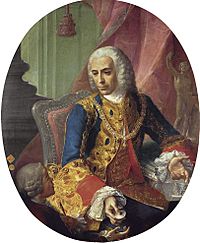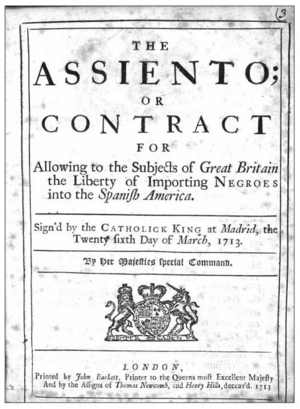Treaty of Madrid (5 October 1750) facts for kids

Spanish negotiator José de Carvajal y Lancáster
|
|
| Context | Britain and Spain agree to terminate the Asiento awarded in 1713, in return for a one-off payment of £100,000 and renew trading rights for merchants in Cádiz |
|---|---|
| Signed | 5 October 1750 |
| Location | Madrid |
| Negotiators | |
| Signatories | |
| Parties | |
| Language | French, Spanish, English |
The Treaty of Madrid, also known as the Treaty of Aquisgran, was an important agreement about trade. It was signed between Britain and Spain on October 5, 1750, in Madrid. This treaty helped to solve several problems between the two countries.
One big issue was the Asiento. This was a special contract that allowed British merchants to supply enslaved people to Spanish America. Spain had given this right to Britain in 1713. There were also problems with British goods being illegally brought into Spain's American colonies. These issues led to a war called the War of Jenkins' Ear in 1739.
After this, the War of the Austrian Succession followed. These wars ended with the Treaty of Aix-la-Chapelle in 1748. However, that treaty didn't fix all the trade problems. British merchants in Cádiz lost their special trading rights. Both Britain and Spain also believed the other owed them a lot of money because of the Asiento.
Luckily, trade through Cadiz was very important for Spain too. Also, Ferdinand VI became king of Spain in 1746. He was more friendly towards Britain than the previous king. This helped both sides agree on a new treaty. The new treaty brought back the trading rights. The Asiento contract was cancelled. In return, Britain received a payment of £100,000.
Contents
Why Was This Treaty Needed?
The 1713 Treaty of Utrecht had given British merchants some access to the closed markets in Spanish America. This included the Asiento de Negros, which allowed them to supply 5,000 enslaved people each year. It also included a Navio de Permiso. This allowed limited direct sales in Porto Bello and Veracruz. The company set up for these rights, the South Sea Company, faced financial trouble. It became owned by the British government.
High taxes on goods officially imported into Spanish America led to a large illegal trade. Many British traders were involved in this smuggling. The Asiento itself didn't make much money. Between 1717 and 1733, only eight ships were sent from Britain for this purpose. The real benefit was that Asiento ships could bring in other goods without paying customs fees.
However, Spanish officials often arrested ships caught with illegal goods. This happened even if the ships were technically linked to the South Sea Company. Other traders illegally supplied enslaved people, which went against the Asiento contract. This led to many arguments about who owed what. By 1748, Britain claimed Spain owed them nearly £2 million. Spain claimed large amounts were owed to them too.
Fixing the Trade Issues
These trade problems led to the War of Jenkins' Ear in 1739. This war became part of the larger War of the Austrian Succession in 1740. The 1748 Treaty of Aix-la-Chapelle didn't really solve these issues. The Asiento was renewed for four years. But the South Sea Company didn't want to continue it.
Much more important was the trade between Britain and Spain through British merchants in Cádiz. British goods were brought in to be sold locally or sent to the colonies. Spanish dyes and wool went the other way. One merchant in London called this trade "the best flower in our garden."
Lord Sandwich was the main British negotiator at Aix-la-Chapelle. He forgot to include the earlier agreements from the Treaty of Utrecht in the new treaty's early talks. When he tried to fix this in the final version, Spain refused. This put the valuable trade between the two countries at risk.
However, both sides wanted to solve the problem. The trade was equally important to Spain. Also, Ferdinand VI was more friendly to Britain than his father, Philip V.
José de Carvajal y Lancáster, Spain's Foreign Minister, talked directly with Sir Benjamin Keene. Keene was an experienced British Ambassador to Spain. They agreed on the main points on October 5, 1749. The treaty was officially approved a year later. The Asiento was cancelled. All claims were settled when Britain received £100,000. The Cadiz merchants could trade again. Britain also got good terms for trading with Spanish America.
What Did the Treaty Say?
The Treaty of Madrid had ten main points:
- Article 1: Britain gave up its claim to the Asiento contract. It also gave up the Navio de Permiso right.
- Article 2: Spain paid Britain £100,000. In return, Britain gave up any claims for more payments.
- Article 3: Spain also gave up its claims related to the Asiento and the Navio de Permiso.
- Article 4: British people would not pay higher taxes in Spanish ports. They would pay the same as during the time of Charles II of England.
- Article 5: British people could gather salt at Tortudos. This was like they did during Charles II's time. This helped them preserve fish to send back to Britain.
- Article 6: British people would not pay higher taxes than Spanish people.
- Article 7: People from both countries would pay the same taxes. This applied whether they brought goods by land or by sea.
- Article 8: Both countries agreed to remove any new trade rules that had caused problems.
- Article 9: Plans were made to include this treaty with other existing agreements.
- Article 10: Both sides promised to carry out the treaty's rules quickly.
What Happened After the Treaty?
Solving these issues helped the Duke of Newcastle. He wanted to improve relations between Britain and Spain. Benjamin Keene helped make sure that ministers who liked Britain were appointed in Spain. These included José de Carvajal and Ricardo Wall.
Even though Keene died in 1757, and Charles III of Spain became king in 1759, Spain stayed neutral. This meant Spain did not take sides in the Seven Years' War between Britain and France until 1762.
Images for kids



